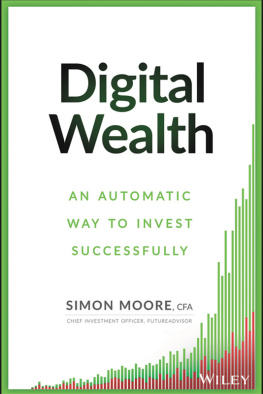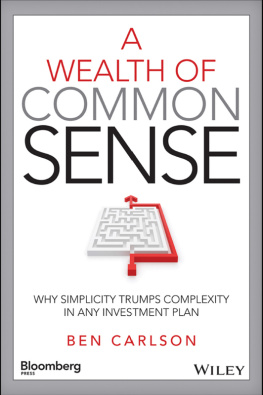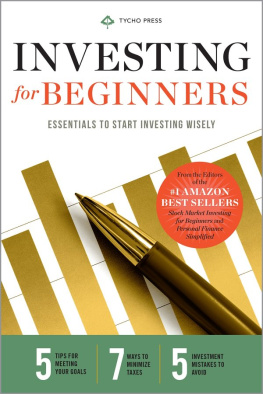
Digital Wealth
An Automatic Way to Invest Successfully
Simon Moore
Cover design: Wiley
Copyright 2016 by Simon Moore. All rights reserved.
Published by John Wiley & Sons, Inc., Hoboken, New Jersey.
Published simultaneously in Canada.
No part of this publication may be reproduced, stored in a retrieval system, or transmitted in any form or by any means, electronic, mechanical, photocopying, recording, scanning, or otherwise, except as permitted under Section 107 or 108 of the 1976 United States Copyright Act, without either the prior written permission of the Publisher, or authorization through payment of the appropriate per-copy fee to the Copyright Clearance Center, Inc., 222 Rosewood Drive, Danvers, MA 01923, (978) 750-8400, fax (978) 646-8600, or on the Web at www.copyright.com. Requests to the Publisher for permission should be addressed to the Permissions Department, John Wiley & Sons, Inc., 111 River Street, Hoboken, NJ 07030, (201) 748-6011, fax (201) 748-6008, or online at http://www.wiley.com/go/permissions.
Limit of Liability/Disclaimer of Warranty: While the publisher and author have used their best efforts in preparing this book, they make no representations or warranties with respect to the accuracy or completeness of the contents of this book and specifically disclaim any implied warranties of merchantability or fitness for a particular purpose. No warranty may be created or extended by sales representatives or written sales materials. The advice and strategies contained herein may not be suitable for your situation. You should consult with a professional where appropriate. Neither the publisher nor author shall be liable for any loss of profit or any other commercial damages, including but not limited to special, incidental, consequential, or other damages.
For general information on our other products and services or for technical support, please contact our Customer Care Department within the United States at (800) 762-2974, outside the United States at (317) 572-3993 or fax (317) 572-4002.
Wiley publishes in a variety of print and electronic formats and by print-on-demand. Some material included with standard print versions of this book may not be included in e-books or in print-on-demand. If this book refers to media such as a CD or DVD that is not included in the version you purchased, you may download this material at http://booksupport.wiley.com. For more information about Wiley products, visit www.wiley.com.
Library of Congress Cataloging-in-Publication Data:
ISBN 9781119118466 (Hardcover)
ISBN 9781119118480 (ePDF)
ISBN 9781119118473 (ePub)
Dedicated to Mum and Dad.
Thank you for everything.
Preface
The future is already here. Its just not very evenly distributed.
William Gibson
In 1989, three separate global events heralded a revolution in household investing, with the potential to save American households billions over the coming decades.
In 1989, researchers from Carnegie Mellon Universitys ChipTest project joined forces with IBM. Their computer was renamed Deep Blue after a naming contest. This chess computer would ultimately defeat the world champion. The same principles of deep analysis and simulation across multiple scenarios are employed by investment algorithms. The technology that beat the world champion once required a room of computing power. Today, as a sign of the incredible improvements in processing power, that same software no longer requires its own room and can run on a basic consumer phone.
In May 1989, Index Participation Shares (IPS) began trading on the American and Philadelphia stock exchanges, an equity derivative attempting to match the returns of the Standard & Poors (S&P) 500. The Chicago Mercantile Exchange sued, and a decision by a Chicago Federal Court ultimately stopped the practice due to regulatory issues. But public interest in trading an entire stock market in the same way that you can trade a single stock was demonstrated in the brief period that this product traded.
The concept ultimately led to a similar fund being set up in Toronto to track the TSE-35 index the next year, which was again short lived, but this led to the first U.S. exchange-traded fund (ETF) four years later. These ETFs ultimately created a low-cost way to track all major liquid asset classes in a tax-efficient manner.

Number of ETFs over Time
Source: Investment Company Institute.
But the innovation was just as powerful in cost as in simplicity. At the turn of the millennium, the average mutual fund charged an expense ratio of 1.6 percent a year; now many ETFs have expense ratios of 0.1 percent or even lower. That represents a 93 percent decline in costs, often with other important benefits in ease of trading and tax efficiency, too.
And in 1989, Tim Beners Lee was in Switzerland pioneering the idea of hypertext to link different computers together. This was the early stages of the Internet. The Web has evolved in critical and unforeseen ways since then. This is the technology that enables investment advice to now be delivered online with tremendous efficiency. These benefits are shared with clients in the form of much lower cost and greater ease of access and implementation than with traditional investment practices.
This book explains how and why algorithmic investing workshow it builds on these three pivotal developments in recent decades spanning different fields. Computational analysis is well suited to large-scale number crunching, with the ability to perform calculations more accurately, frequently, and without error than humans. In addition to that discussion of what powers algorithmic investing, you will see how a low-cost approach and diversified approach to investing has historically led to better results and how this finding is supported by many academic studies. One major theme that research shows is how lower-cost investing typically provides superior results than more expensive strategies.
In turn, digital investment advice embodies decades of financial development including Nobel Prizewinning economic thinking. This book also explains the often overlooked area of tax-efficient investing and how the markets focus on pretax returns misses one of the easiest ways to improve performance. This is because beating the market is challenging given the competitive forces in play, yet tax efficiency offers a way to potentially increase portfolio returns in a more sustainable manner.
Unfortunately, today Americas savings rate is too low for many and is well below historic norms. Many are still overpaying for investment advice or unintentionally mismanaging their own investment portfolio due to behavioral and other biases. This book explains what the future of investment management is likely to look like based on the tremendous growth of both ETFs as an asset class and digital investment advisors as an important service.
Investment advice has previously been the preserve of the wealthy, and digital advisors pose less of a threat to the traditional financial advisor and more of an opportunity for the field of financial advice to reach the majority of households who are managing their own portfolio. This shift should save countless households significant time and effort, while providing peace of mind on some of lifes most important but often neglected topics.
Next page
















